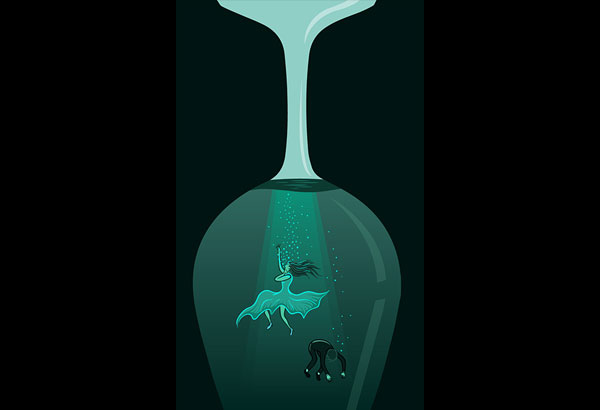The bottom of the bottle

Art by Karl Adrian So
There are a number of reasons to pay attention to the various aspects of alcohol abuse. The problem is that we don’t. Why it matters: it has been said that of all psychoactive substances, alcohol is the culprit that poses the greatest threat to public health and safety, partly due to easy access. Most importantly, among friends, it can be difficult to tell when the recreational activity of drinking mutates into a condition of chronic dependence.
By way of data, however, we don’t have much. According to a 2004 report by the World Health Organization, statistics are very difficult to access in the Philippines. That this dated study is one of the first searches to come up says volumes about how poorly the reality of alcohol abuse is documented. “However,” the study goes on to say, “while there may be no official statistics available, the consequences of alcoholism are very obvious in the community or inside homes. There are many undocumented cases of alcoholic persons who collapsed in the street because of drunkenness. Alcoholism is a growing concern in the culture and social life of this country.”
The study goes on to cite sociological factors. “In recent years, only a few alcohol-related cases have been recorded by the Philippine General Hospital. This could be due to the fact that alcoholism is not considered a medical problem by most Filipinos. Most Filipinos with an alcohol problem do not submit to medical treatment even if their condition is chronic. Alcohol rehabilitation centers have low admission rates compared to similar institutions for illicit drug dependency.” Perhaps it is an underestimation of how harmful alcohol can be as a substance, plus — and this is especially relevant in these times — a disproportionately huge amount of focus paid to other drugs.
(Let’s get this out of the way real quick though — at the risk of sounding like “kewl” parents or hip guidance counselors, there’s nothing wrong with getting faded as long as you’re smart about it. Let’s assume, though, that no one reading this wants to grow up to be the tito who drinks Johnny Walker at 10 in the morning for breakfast.)
In cases where we lack data, we can turn to authorities on the study of addiction. Teresita Castillo is a recovery coach and co-founder of Seagulls Flight Foundation, Inc., which is a non-profit organization and residential facility that provides treatment and rehabilitation for those addicted to drugs, gambling, gaming, and, of course, drinking. Her husband and the organization’s co-founder, Eddie, has been in recovery for 40 years, which means Teresita’s insights come from a great deal of personal experience.
It’s reasonable to say that alcoholism is a different beast when experienced during adolescence or young adulthood, what with the unique pressures that come with youth. Teresita elaborates. “In Filipino culture, young boys are ‘baptized’ through their first taste of alcohol initiated either by the male elders (titos and kuyas) in the family or among their peers,” Teresita notes. “It becomes `a rite of passage’ to manhood. As teenagers, they are unmindful of the ill effects of alcohol thus they take every opportunity to sneakily get the chance to drink among their peers.”
This might be a general case limited to boys, but the reasons one might turn to alcohol vary from person to person, and such experiences are singular in their specificity. Samantha, who admits to have depended on alcohol heavily before, recounts her motivations. “At that time I was in an emotionally abusive long-term relationship with a guy five years older than me,” she says. “Because of my experiences with him, I suffered from depression, I think. It wasn’t really therapist-official but I felt that something was wrong. Alcohol was my refuge and it definitely helped me sleep and forget things.”
The way the addiction manifests is a little more difficult to pin down, which is why it’s often tricky to tell the difference between an actual problem and just “drinking for fun.” Though specific signs and situations can elude formal study, Teresita offers a general rubric for how to spot a possible addiction. To name a few examples: relationships and responsibilities are neglected; major obligations at school, work and home are given up; a great deal of time is spent “seeking, using, and recovering from the effects of alcohol.” Even then, one can’t always count on public displays of dysfunction. Samantha notes that she would drink by herself, in the evening, away from the prying eyes of friends and family.
What’s to be done, then? Perhaps the first and best place to start is to promote a change in mindset. “Stigma is among the biggest factors that holds people with substance use disorder back from seeking help and getting treatment. Because of fear that they will be labeled in a negative context, they withdraw themselves from possible help and just allow themselves to get deeper into their addiction.” Teresita notes. Or, to put it more simply, “Addiction is a chronic and relapsing brain disease; not a moral impairment of a person. You don’t stigmatize someone who is ill, you give them treatment.”
Treatment and recovery can also be tricky realities to navigate. Cases like Samantha’s are rare, where the person with alcohol dependence manages to recognize it and stop before things get so bad that outside intervention becomes necessary. Teresita’s perspective however is unique, not because of her experience as a psychologist but her background as a “recovery coach,” which takes a more personal and less clinical approach than therapists and forms a human connection with their clients through a shared personal experience with addiction. Basically, the difference between a therapist and a recovery coach is that the latter can say, with greater honesty, “I feel you.”
Teresita paints a picture of what the recovery process looks like. “Given that addiction is a chronic relapsing brain disease, a change of lifestyle and developing positive coping skills needed in stressful and high-risk situations are very important. Furthermore, a person with substance use disorder may have some internal issues (personality disorder, trauma, depression, anxiety, etc.) that also need equal attention. This is when both psychiatric and psychological therapy come in.” There are even recovery strategies that are faith-based, taking a more spiritual/religious approach in looking after an alcoholic’s well-being.
These experiences and insights barely cover the full reality of alcoholism, though. The addiction can enact its power in various forms: how an alcoholic parent creates a broken home; alcohol as one aspect of a full-blown dependence on narcotics; the romanticizing of drinking as the best antidote for sorrow. But we can hold fast to certain truths. Admitting you need help doesn’t make you less of a person. Intervening doesn’t make you a killjoy. Addiction is a call for help, not an indication of moral decline. We need to believe in and face these things, as hard as they can be to swallow.
















